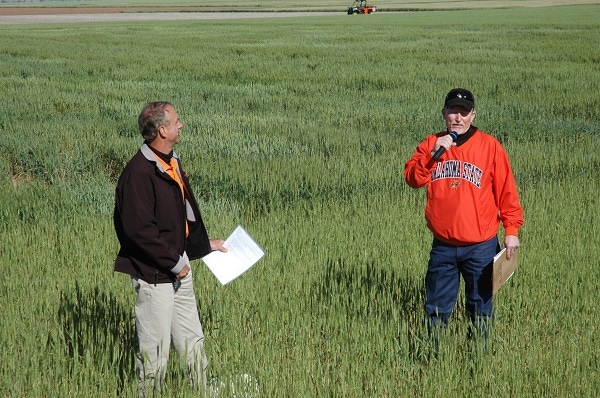
Developing new wheat varieties with improved nitrogen and water use efficiency, along with increased resistance or tolerance to plant disease, while maintaining or improving agronomic and milling qualities offers a big trial for researchers.
But Brett Carver, Oklahoma State University wheat genetics and breeding, and Bryan Arnall, OSU precision nutrient management, are taking on the challenge, working together at the Tipton Valley Research Center to identify more efficient wheat varieties.
Funding from the National Institute for Food and Agriculture (NIFA) is aiding researchers in finding more efficient wheat varieties, Carver said. “The big focus issues are water use, nitrogen use and disease resistance,” he said during a recent research center field day.
Arnall said the Tipton station provides a good site for nutrient studies since the soil has little residual fertility, allowing researchers to evaluate various levels of nitrogen use.
For the latest on Southwest agriculture, please check out Southwest Farm Press Daily and receive the latest news right to your inbox.
Carver said molecular technology will be crucial to his variety selection process. “We’re moving toward a more DNA approach,” he said. “We are also teaming up with the University of Nebraska in the effort.”
The project has been ongoing for several years but has been dogged by calamity, including a 2011 tornado that destroyed the research facility. “But the plants survived,” Carver said. Drought has been a constant stress for the past three years as well.
Making progress
Still, they have made progress, paring down 300 hard red winter wheat lines to 12 with increased nitrogen use efficiency. Test plots include nitrogen rates from zero to 100 pounds per acre, in increments. “We will use the data from the trials to select lines for breeding programs,” Carver said. “We’re also looking at some soft wheat varieties.”
The overall goal is optimistic. “We want to get drought tolerance and nitrogen use efficiency wrapped into one,” Carver said. “That’s not an easy task. Nitrogen use is a complicated trait system in wheat.”
He said a researcher at Stillwater has “found a hot spot in the wheat genome, with GM technology.” Carver says the GM process does not take something from a foreign plant and insert it into the wheat but takes a gene from wheat.
The Tipton station also supports an on-site advanced line breeding program. An experimental variety, OK09125, has shown promise and “looks good over a wide range of environments. We have not released it because of concern over kernel size,” Carver said.
Arnall said identifying nitrogen use efficiency (NUE) in wheat is a challenge. “We have two kinds of NUE, plants that scavenge for nitrogen and plants that make good use of available nitrogen. A perfect combination,” he said, would be a variety that could do both.
He said wheat researchers are fortunate to have the Tipton facility available. “This is the most responsive nitrogen site in the state—when we get moisture to make a yield. The response and uniformity at this location is extremely rare in Oklahoma.”
He uses nitrogen rich (N-rich) strips to evaluate fertility needs. Those strips, fertilized in increments from zero to 100 pounds of nitrogen per acre, indicate in-season how much supplemental nitrogen the wheat needs.
N-rich strips
“We plan to use more N-rich strips,” Arnall said. “We want to get away from a lot of pre-plant fertilization.”
He said good fertility management would call for adding some fertilizer in anticipation of the next year. But he cautions against adding too much early-season nitrogen that might be wasted. “I like a little starter, 30 to 50 pounds per acre, but there is no reason to have 120 pounds of nitrogen under the crop.”
N-rich strips, he said, allow a producer to evaluate crop prospects during the season and add fertilizer as needed.
Mark Gregory, area Extension agronomist, discussed wheat plots with “varieties that are now available to growers.” He noted that one plot was “non-replicated and showed a great deal of difference between varieties. We have to ask if the difference was the variety or something else. That’s why replicated plots are important.”
He said identifying disease resistance is an important part of variety trials. “We are trying to identify varieties susceptible to a specific race of stripe rust,” he said.
Gregory also commented on the importance of buying certified seed and explained that the higher cost comes from the increased amount of care growers have to take to produce the seed. “They have to clean out combines, augers and storage bins,” he said. “They also have to do a lot more paperwork.” He said farmers who monocrop wheat cannot have planted another variety on the field where they plant certified seed. “Also, certified seed are under the Plant Variety Protection Act and can’t be brown-bagged.”
Farmers wishing to buy OSU wheat varieties now have to be a member of OSU Genetic Incorporated. “Members can grow seed and sell to other farmers.”
About the Author(s)
You May Also Like






